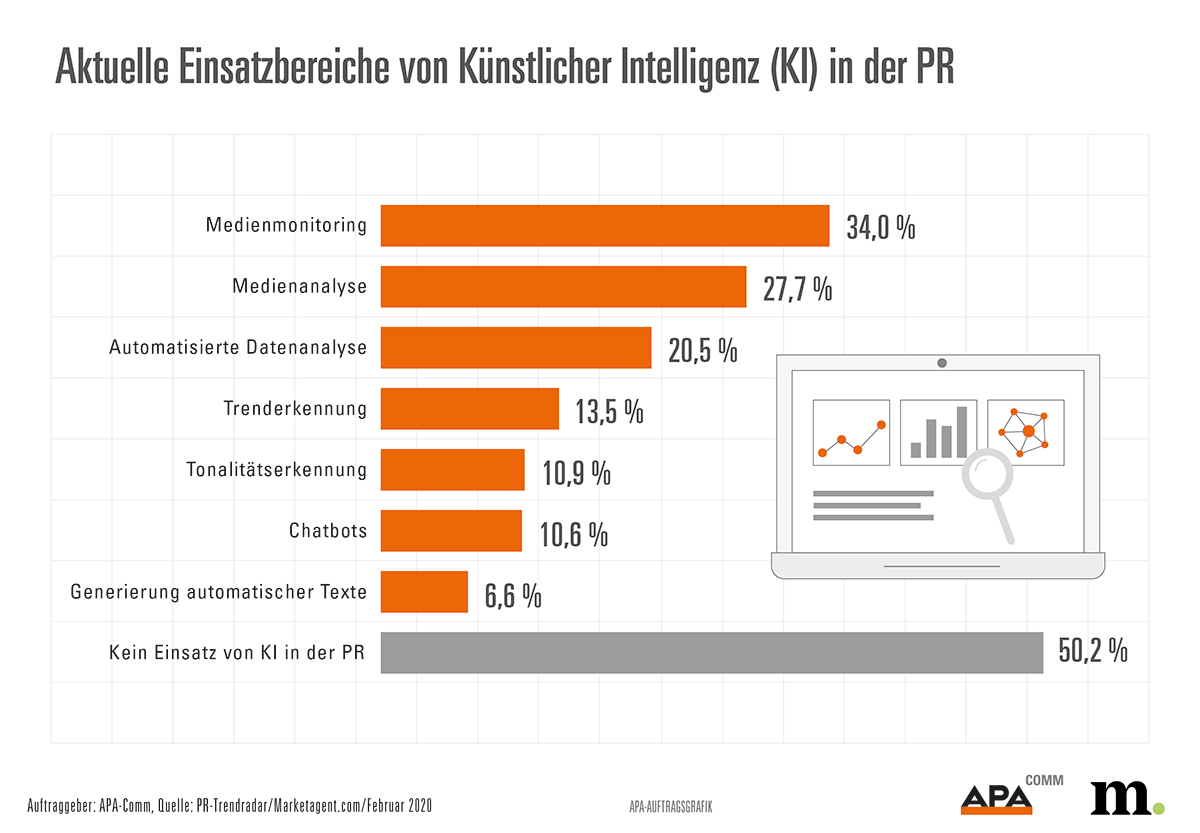Digital PR: "We're all sitting in one big lab"
New channels, rapidly growing platforms, AI and rapidly changing user behavior - these and other developments are changing the tasks and opportunities of PR managers. Marketagent.com has examined the status quo and trends in the communications industry on behalf of APA-Comm as part of the PR-Trendradar survey series.

A balanced mix of analog and digital communication will prove its worth in the future, 96 percent of the survey participants agree, explains Lisa Patek, Marketing Manager at Marketagent.com. The survey polled 303 experts from the fields of marketing and communications. Around three quarters of respondents believe that companies cannot be successful in the long term without digital PR.
Awareness of the importance of a documented strategy for digital communications has increased. Whereas in a Trend Radar survey in 2017 more than half of the respondents said they were working without one, by 2020 the figure was only 21 percent.Trends in digital communication
Personalized content and offers represent the most significant trend in digital PR for 62 percent of respondents, followed by live videos (33 percent) and artificial intelligence (30 percent). When it comes to communication channels, Instagram is at the top: 62 percent expect the photo platform to become even more important in the future - YouTube (61 percent) and LinkedIn (53 percent) are also seen as having growing relevance for the PR industry.

The global mega-topic of artificial intelligence has already become part of everyday professional life for many domestic communications professionals. 34 percent use such algorithms for media monitoring, 28 percent for media analysis and about one fifth for automated data analysis.

The main advantages are seen as "facilitation of work" and "relief for employees". "More errors due to algorithms" and "Lack of quality of output" are the biggest challenges according to the survey. Half of the respondents do not yet use any tools or technologies based on artificial intelligence in their area of work.

More channels, more interaction
The results of the study were discussed by PR experts at the APA-Comm in Vienna on Tuesday. There were different assessments of the digital PR of today and tomorrow. "Classic PR is losing its business model," said Thomas Lutz, Head of Communication at Microsoft Austria. PR no longer consists of focusing only on media, he said. He has the approach of being his own medium, Lutz explained: "I have my own little portal and through that I control my content - I call it 'Amplified Media' - I try to amplify what I have as content, to spread it beyond social media into the most diverse channels."
Julia Wippersberg, Managing Director of APA-OTS, emphasized that PR is not an end in itself. It is never just about reaching the media, she said; communication must work for the company and contribute to increasing its value. "Image and reputation are ways to get there, but not the exclusive and ultimate goal of communication," Wippersberg affirmed. Digital channels have a key advantage, he said, because customers can tell a company directly what they don't like about a product. "Those for whom we do the communication can be much better involved through digital PR," the expert summarized.
Ethical issues through new opportunities
"We are all sitting in a big laboratory - socially speaking," explained Susanne Grof-Korbel, Managing Director of Bettertogether, drawing attention to sensitive aspects of the new digital possibilities. This laboratory situation, she said, brings with it many ethical issues, especially where advertising and PR overlap. As an example from the digital communications world, Grof-Korbel cited beauty events for children. "That's where the influencers sit, and those girls like to watch them on YouTube." From a marketing point of view, that would be positive because new target groups would be opened up, but from an ethical point of view, he said, the question has to be asked: "Do I have to do everything now because it's possible?"
"The ethical question is not a PR question - it's corporate ethics," added Markus Setznagel, Senior PR Manager at Austrian Airlines. Even what would initially be good from a marketing point of view would eventually "shoot back" if the measures were not well received by society. To meet the challenges of digitization, Austrian Airlines is relying on a newsroom concept. According to Setznagel, everything revolves around the basic consideration: What is the topic and how do I reach the target group with it? Only then can the format and channel be determined. "The newsroom concept thrives on the fact that you have to work much more openly with each other," says Setznagel. In this constellation, "channel managers" work closely with "topic managers," who plan the communication measures in daily joint editorial meetings of the transnational group of companies.
More self-determination through artificial intelligence
"Technical jargon remains technical jargon, no matter how you communicate it," noted Klaus Candussi, managing director of Atempo, backing up his point with empirical figures: 60 percent of the population cannot comprehend what quality media, companies, and government agencies communicate because the level of linguistic complexity is too high. To counteract this, atempo is working with various partner organizations to enable more people to understand. Among other things, easy-to-understand news is offered together with the Austria Press Agency. Through digitalization and the use of artificial intelligence, Candussi expects, texts of all kinds can be automatically translated into simple language in the future, making a significant contribution to the self-determination of many people.
The panel agreed that artificial intelligence has a lot of potential to make work easier in a digitalized PR industry and free up capacity for creative processes. (pd)








